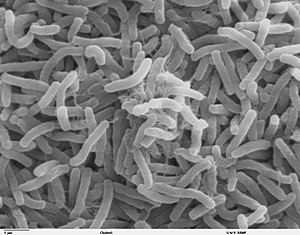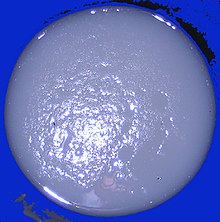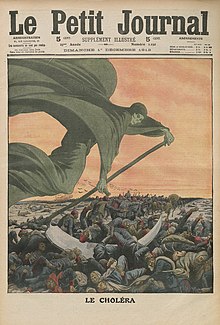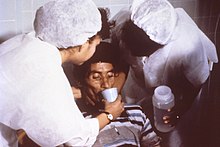From Wikipedia, the free encyclopedia
| Cholera | |
|---|---|
| Classification and external resources | |

Scanning electron microscope image of Vibrio cholerae
|
|
| ICD-10 | A00 |
| ICD-9 | 001 |
| DiseasesDB | 29089 |
| MedlinePlus | 000303 |
| eMedicine | med/351 |
| MeSH | D002771 |
Contents
Signs and symptoms
If the severe diarrhea is not treated with intravenous rehydration, it can result in life-threatening dehydration and electrolyte imbalances.[1] The typical symptoms of dehydration include low blood pressure, poor skin turgor (wrinkled hands), sunken eyes, and a rapid pulse.[1]
Cause
Main article: Vibrio cholerae

Vibrio cholerae, the bacterium that causes cholera
Susceptibility
About 100 million bacteria must typically be ingested to cause cholera in a normal healthy adult.[1] This dose, however, is less in those with lowered gastric acidity (for instance those using proton pump inhibitors).[1] Children are also more susceptible, with two- to four-year-olds having the highest rates of infection.[1] Individuals' susceptibility to cholera is also affected by their blood type, with those with type O blood being the most susceptible.[1][7] Persons with lowered immunity, such as persons with AIDS or children who are malnourished, are more likely to experience a severe case if they become infected.[8] However, it should be noted that any individual, even a healthy adult in middle age, can experience a severe case, and each person's case should be measured by the loss of fluids, preferably in consultation with a professional health care provider.The cystic fibrosis genetic mutation in humans has been said to maintain a selective advantage: heterozygous carriers of the mutation (who are thus not affected by cystic fibrosis) are more resistant to V. cholerae infections.[9] In this model, the genetic deficiency in the cystic fibrosis transmembrane conductance regulator channel proteins interferes with bacteria binding to the gastrointestinal epithelium, thus reducing the effects of an infection.
Transmission
Cholera is typically transmitted by either contaminated food or water. In the developed world, seafood is the usual cause, while in the developing world it is more often water.[1] Cholera has been found in only two other animal populations: shellfish and plankton.[1]People infected with cholera often have diarrhea, and if this highly liquid stool, colloquially referred to as "rice-water", contaminates water used by others, disease transmission may occur.[10] The source of the contamination is typically other cholera sufferers when their untreated diarrheal discharge is allowed to get into waterways, groundwater or drinking water supplies. Drinking any infected water and eating any foods washed in the water, as well as shellfish living in the affected waterway, can cause a person to contract an infection. Cholera is rarely spread directly from person to person. Both toxic and nontoxic strains exist. Nontoxic strains can acquire toxicity through a temperate bacteriophage.[11] Coastal cholera outbreaks typically follow zooplankton blooms, thus making cholera a zoonotic disease.
Mechanism
When consumed, most bacteria do not survive the acidic conditions of the human stomach.[12] The few surviving bacteria conserve their energy and stored nutrients during the passage through the stomach by shutting down much protein production. When the surviving bacteria exit the stomach and reach the small intestine, they need to propel themselves through the thick mucus that lines the small intestine to get to the intestinal walls where they can thrive. V. cholerae bacteria start up production of the hollow cylindrical protein flagellin to make flagella, the cork-screw helical fibers they rotate to propel themselves through the mucus of the small intestine.Once the cholera bacteria reach the intestinal wall they no longer need the flagella to move. The bacteria stop producing the protein flagellin to conserve energy and nutrients by changing the mix of proteins which they express in response to the changed chemical surroundings. On reaching the intestinal wall, V. cholerae start producing the toxic proteins that give the infected person a watery diarrhea. This carries the multiplying new generations of V. cholerae bacteria out into the drinking water of the next host if proper sanitation measures are not in place.
The cholera toxin (CTX or CT) is an oligomeric complex made up of six protein subunits: a single copy of the A subunit (part A), and five copies of the B subunit (part B), connected by a disulfide bond. The five B subunits form a five-membered ring that binds to GM1 gangliosides on the surface of the intestinal epithelium cells. The A1 portion of the A subunit is an enzyme that ADP-ribosylates G proteins, while the A2 chain fits into the central pore of the B subunit ring. Upon binding, the complex is taken into the cell via receptor-mediated endocytosis. Once inside the cell, the disulfide bond is reduced, and the A1 subunit is freed to bind with a human partner protein called ADP-ribosylation factor 6 (Arf6).[13] Binding exposes its active site, allowing it to permanently ribosylate the Gs alpha subunit of the heterotrimeric G protein. This results in constitutive cAMP production, which in turn leads to secretion of H2O, Na+, K+, Cl−, and HCO3− into the lumen of the small intestine and rapid dehydration. The gene encoding the cholera toxin is introduced into V. cholerae by horizontal gene transfer. Virulent strains of V. cholerae carry a variant of temperate bacteriophage called CTXf or CTXφ.
Microbiologists have studied the genetic mechanisms by which the V. cholerae bacteria turn off the production of some proteins and turn on the production of other proteins as they respond to the series of chemical environments they encounter, passing through the stomach, through the mucous layer of the small intestine, and on to the intestinal wall.[14] Of particular interest have been the genetic mechanisms by which cholera bacteria turn on the protein production of the toxins that interact with host cell mechanisms to pump chloride ions into the small intestine, creating an ionic pressure which prevents sodium ions from entering the cell. The chloride and sodium ions create a salt-water environment in the small intestines, which through osmosis can pull up to six litres of water per day through the intestinal cells, creating the massive amounts of diarrhea. The host can become rapidly dehydrated if an appropriate mixture of dilute salt water and sugar is not taken to replace the blood's water and salts lost in the diarrhea.
By inserting separate, successive sections of V. cholerae DNA into the DNA of other bacteria, such as E. coli that would not naturally produce the protein toxins, researchers have investigated the mechanisms by which V. cholerae responds to the changing chemical environments of the stomach, mucous layers, and intestinal wall. Researchers have discovered a complex cascade of regulatory proteins controls expression of V. cholerae virulence determinants. In responding to the chemical environment at the intestinal wall, the V. cholerae bacteria produce the TcpP/TcpH proteins, which, together with the ToxR/ToxS proteins, activate the expression of the ToxT regulatory protein. ToxT then directly activates expression of virulence genes that produce the toxins, causing diarrhea in the infected person and allowing the bacteria to colonize the intestine.[14] Current research aims at discovering "the signal that makes the cholera bacteria stop swimming and start to colonize (that is, adhere to the cells of) the small intestine."[14]
Genetic structure
Amplified fragment length polymorphism fingerprinting of the pandemic isolates of V. cholerae has revealed variation in the genetic structure. Two clusters have been identified: Cluster I and Cluster II. For the most part, Cluster I consists of strains from the 1960s and 1970s, while Cluster II largely contains strains from the 1980s and 1990s, based on the change in the clone structure. This grouping of strains is best seen in the strains from the African continent.[15]Diagnosis
A rapid dip-stick test is available to determine the presence of V. cholerae.[6] In those samples that test positive, further testing should be done to determine antibiotic resistance.[6] In epidemic situations, a clinical diagnosis may be made by taking a patient history and doing a brief examination. Treatment is usually started without or before confirmation by laboratory analysis.Stool and swab samples collected in the acute stage of the disease, before antibiotics have been administered, are the most useful specimens for laboratory diagnosis. If an epidemic of cholera is suspected, the most common causative agent is V. cholerae O1. If V. cholerae serogroup O1 is not isolated, the laboratory should test for V. cholerae O139. However, if neither of these organisms is isolated, it is necessary to send stool specimens to a reference laboratory. Infection with V. cholerae O139 should be reported and handled in the same manner as that caused by V. cholerae O1. The associated diarrheal illness should be referred to as cholera and must be reported in the United States.[16]
A number of special media have been employed for the cultivation for cholera vibrios. They are classified as follows:
Enrichment media
- Alkaline peptone water at pH 8.6
- Monsur's taurocholate tellurite peptone water at pH 9.2
Plating media
- Alkaline bile salt agar (BSA): The colonies are very similar to those on nutrient agar.
- Monsur's gelatin Tauro cholate trypticase tellurite agar (GTTA) medium: Cholera vibrios produce small, translucent colonies with a greyish-black center.
- TCBS medium: This is the mostly widely used medium; it contains thiosulphate, citrate, bile salts and sucrose. Cholera vibrios produce flat, 2–3-mm-diameter, yellow-nucleated colonies.
Prevention
Although cholera may be life-threatening, prevention of the disease is normally straightforward if proper sanitation practices are followed. In developed countries, due to nearly universal advanced water treatment and sanitation practices, cholera is no longer a major health threat. The last major outbreak of cholera in the United States occurred in 1910–1911.[17][18] Effective sanitation practices, if instituted and adhered to in time, are usually sufficient to stop an epidemic. There are several points along the cholera transmission path at which its spread may be halted:- Sterilization: Proper disposal and treatment of infected fecal waste water produced by cholera victims and all contaminated materials (e.g. clothing, bedding, etc.) are essential. All materials that come in contact with cholera patients should be sanitized by washing in hot water, using chlorine bleach if possible. Hands that touch cholera patients or their clothing, bedding, etc., should be thoroughly cleaned and disinfected with chlorinated water or other effective antimicrobial agents.
- Sewage: antibacterial treatment of general sewage by chlorine, ozone, ultraviolet light or other effective treatment before it enters the waterways or underground water supplies helps prevent undiagnosed patients from inadvertently spreading the disease.
- Sources: Warnings about possible cholera contamination should be posted around contaminated water sources with directions on how to decontaminate the water (boiling, chlorination etc.) for possible use.
- Water purification: All water used for drinking, washing, or cooking should be sterilized by either boiling, chlorination, ozone water treatment, ultraviolet light sterilization (e.g. by solar water disinfection), or antimicrobial filtration in any area where cholera may be present. Chlorination and boiling are often the least expensive and most effective means of halting transmission. Cloth filters or sari filtration, though very basic, have significantly reduced the occurrence of cholera when used in poor villages in Bangladesh that rely on untreated surface water. Better antimicrobial filters, like those present in advanced individual water treatment hiking kits, are most effective. Public health education and adherence to appropriate sanitation practices are of primary importance to help prevent and control transmission of cholera and other diseases.
Surveillance
Surveillance and prompt reporting allow for containing cholera epidemics rapidly. Cholera exists as a seasonal disease in many endemic countries, occurring annually mostly during rainy seasons. Surveillance systems can provide early alerts to outbreaks, therefore leading to coordinated response and assist in preparation of preparedness plans. Efficient surveillance systems can also improve the risk assessment for potential cholera outbreaks. Understanding the seasonality and location of outbreaks provides guidance for improving cholera control activities for the most vulnerable.[19] For prevention to be effective, it is important that cases be reported to national health authorities.[1]Vaccine
Main article: Cholera vaccine
A number of safe and effective oral vaccines for cholera are available.[20] Dukoral,
an orally administered, inactivated whole cell vaccine, has an overall
efficacy of about 52% during the first year after being given and 62% in
the second year, with minimal side effects.[20] It is available in over 60 countries. However, it is not currently recommended by the Centers for Disease Control and Prevention (CDC) for most people traveling from the United States to endemic countries.[21]
One injectable vaccine was found to be effective for two to three
years. The protective efficacy was 28% lower in children less than 5
years old.[22] However, as of 2010, it has limited availability.[5] Work is under way to investigate the role of mass vaccination.[23] The World Health Organization (WHO) recommends immunization of high risk groups, such as children and people with HIV, in countries where this disease is endemic.[5] If people are immunized broadly, herd immunity results, with a decrease in the amount of contamination in the environment.[6]Sari filtration
An effective and relatively cheap method to prevent transmission of V. cholera is the practice of folding a sari (a long fabric garment) multiple times to create a simple filter for drinking water.[24] Folding saris four to eight times may create a simple filter to reduce the amount of active V. cholera in the filtered water.[25] Education in proper sari filter use is imperative, as there is a positive correlation between sari misuse and the incidence of childhood diarrhea; soiled saris worn by women are vectors of transmission of enteric pathogens to young children.[26] Educating at-risk populations about the proper use of the sari filter method may decrease V. cholera-associated disease.Treatment
Continued eating speeds the recovery of normal intestinal function. The World Health Organization recommends this generally for cases of diarrhea no matter what the underlying cause.[27] A CDC training manual specifically for cholera states: “Continue to breastfeed your baby if the baby has watery diarrhea, even when traveling to get treatment. Adults and older children should continue to eat frequently.”[28]Fluids
In most cases, cholera can be successfully treated with oral rehydration therapy (ORT), which is highly effective, safe, and simple to administer.[6] Rice-based solutions are preferred to glucose-based ones due to greater efficiency.[6] In severe cases with significant dehydration, intravenous rehydration may be necessary. Ringer's lactate is the preferred solution, often with added potassium.[1][27] Large volumes and continued replacement until diarrhea has subsided may be needed.[1] Ten percent of a person's body weight in fluid may need to be given in the first two to four hours.[1] This method was first tried on a mass scale during the Bangladesh Liberation War, and was found to have much success.[29]If commercially produced oral rehydration solutions are too expensive or difficult to obtain, solutions can be made. One such recipe calls for 1 liter of boiled water, 1/2 teaspoon of salt, 6 teaspoons of sugar, and added mashed banana for potassium and to improve taste.[30]
Electrolytes
As there frequently is initially acidosis, the potassium level may be normal, even though large losses have occurred.[1] As the dehydration is corrected, potassium levels may decrease rapidly, and thus need to be replaced.[1]Antibiotics
Antibiotic treatments for one to three days shorten the course of the disease and reduce the severity of the symptoms.[1] Use of antibiotics also reduces fluid requirements.[31] People will recover without them, however, if sufficient hydration is maintained.[6] Doxycycline is typically used first line, although some strains of V. cholerae have shown resistance.[1] Testing for resistance during an outbreak can help determine appropriate future choices.[1] Other antibiotics proven to be effective include cotrimoxazole, erythromycin, tetracycline, chloramphenicol, and furazolidone.[32] Fluoroquinolones, such as norfloxacin, also may be used, but resistance has been reported.[33]In many areas of the world, antibiotic resistance is increasing. In Bangladesh, for example, most cases are resistant to tetracycline, trimethoprim-sulfamethoxazole, and erythromycin.[6] Rapid diagnostic assay methods are available for the identification of multiple drug-resistant cases.[34] New generation antimicrobials have been discovered which are effective against in in vitro studies.[35]
Prognosis
If people with cholera are treated quickly and properly, the mortality rate is less than 1%; however, with untreated cholera, the mortality rate rises to 50–60%.[1][36] For certain genetic strains of cholera, such as the one present during the 2010 epidemic in Haiti and the 2004 outbreak in India, death can occur within two hours of becoming ill.[37]Epidemiology
See also: Cholera outbreaks and pandemics

Hand bill from the New York City Board of Health, 1832—the outdated public health advice demonstrates the lack of understanding of the disease and its actual causative factors.
Although much is known about the mechanisms behind the spread of cholera, this has not led to a full understanding of what makes cholera outbreaks happen some places and not others. Lack of treatment of human feces and lack of treatment of drinking water greatly facilitate its spread, but bodies of water can serve as a reservoir, and seafood shipped long distances can spread the disease. Cholera was not known in the Americas for most of the 20th century, but it reappeared towards the end of that century.[40]
History
The word cholera is from Greek: χολέρα kholera from χολή kholē "bile". Cholera likely has its origins in the Indian Subcontinent; it has been prevalent in the Ganges delta since ancient times.[1] The disease first spread by trade routes (land and sea) to Russia in 1817, then to the rest of Europe, and from Europe to North America.[1] Seven cholera pandemics have occurred in the past 200 years, with the seventh originating in Indonesia in 1961.[41]
Map of the 2008–2009 cholera outbreak in sub-Saharan Africa showing the statistics as of 12 February 2009.
From a local disease, cholera became one of the most widespread and deadly diseases of the 19th century, killing an estimated tens of millions of people.[43] In Russia alone, between 1847 and 1851, more than one million people perished of the disease.[44] It killed 150,000 Americans during the second pandemic.[45] Between 1900 and 1920, perhaps eight million people died of cholera in India.[46] Cholera became the first reportable disease in the United States due to the significant effects it had on health.[1] John Snow, in England, was the first to identify the importance of contaminated water in its cause in 1854.[1] Cholera is now no longer considered a pressing health threat in Europe and North America due to filtering and chlorination of water supplies, but still heavily affects populations in developing countries.
In the past, vessels flew a yellow quarantine flag if any crew members or passengers were suffering from cholera. No one aboard a vessel flying a yellow flag would be allowed ashore for an extended period, typically 30 to 40 days.[47] In modern sets of international maritime signal flags, the quarantine flag is yellow and black.

Signal flag "Lima" called the "Yellow Jack" which when flown in harbor means ship is under quarantine. A simple yellow flag (also called the "Yellow Jack") had historically been used to signal quarantine (it stands for Q
among signal flags), but now indicates the opposite, as a signal of a
ship free of disease that requests boarding and inspection.
Cholera Morbus
The term Cholera Morbus was used in the 19th and early 20th centuries to describe both nonepidemic cholera and other gastrointestinal diseases (sometimes epidemic) that resembled cholera. The term is not in current use, but is found in many older references.[50] The other diseases are now known collectively as gastroenteritis.Research
The Russian-born bacteriologist Waldemar Haffkine developed the first cholera vaccine around 1900. The bacterium had been originally isolated 45 years earlier (1855) by Italian anatomist Filippo Pacini, but its exact nature and his results were not widely known. However, a remedy was not found until 1885, when Spanish bacteriologist and sanitarian Jaime Ferrán y Clua (1851-1929) developed the first vaccine against cholera.One of the major contributions to fighting cholera was made by the physician and pioneer medical scientist John Snow (1813–1858), who in 1854 found a link between cholera and contaminated drinking water.[51] Dr. Snow proposed a microbial origin for epidemic cholera in 1849. In his major "state of the art" review of 1855, he proposed a substantially complete and correct model for the etiology of the disease. In two pioneering epidemiological field studies, he was able to demonstrate human sewage contamination was the most probable disease vector in two major epidemics in London in 1854.[52] His model was not immediately accepted, but it was seen to be the more plausible, as medical microbiology developed over the next 30 years or so.

Robert Koch (third from the right) on a cholera research expedition in Egypt in 1884, one year after he identified V. cholerae.
Robert Allan Phillips, working at the US Naval Medical Research Unit Two in Southeast Asia, evaluated the pathophysiology of the disease using modern laboratory chemistry techniques and developed a protocol for rehydration. His research led the Lasker Foundation to award him its prize in 1967.[citation needed]
Cholera has been a laboratory for the study of evolution of virulence. The province of Bengal in British India was partitioned into West Bengal and East Pakistan in 1947. Prior to partition, both regions had cholera pathogens with similar characteristics. After 1947, India made more progress on public health than East Pakistan (now Bangladesh). As a consequence,[clarification needed] the strains of the pathogen that succeeded in India had a greater incentive in the longevity of the host. They have become less virulent than the strains prevailing in Bangladesh. These draw upon the resources of the host population and rapidly kill many victims.
More recently, in 2002, Alam, et al., studied stool samples from patients at the International Centre for Diarrhoeal Disease in Dhaka, Bangladesh. From the various experiments they conducted, the researchers found a correlation between the passage of V. cholerae through the human digestive system and an increased infectivity state. Furthermore, the researchers found the bacterium creates a hyperinfected state where genes that control biosynthesis of amino acids, iron uptake systems, and formation of periplasmic nitrate reductase complexes were induced just before defecation. These induced characteristics allow the cholera vibrios to survive in the "rice water" stools, an environment of limited oxygen and iron, of patients with a cholera infection.[54]
Notable cases
- Tchaikovsky's death has traditionally been attributed to cholera, most probably contracted through drinking contaminated water several days earlier.[55] "Since the water was not boiled and cholera was affecting Saint Petersburg, such a connection is quite plausible ...."[56] Tchaikovsky's mother died of cholera,[57] and his father became sick with cholera at this time but made a full recovery.[58] Some scholars, however, including English musicologist and Tchaikovsky authority David Brown and biographer Anthony Holden, have theorized that his death was a suicide.[59]
- After the 2010 earthquake, an outbreak swept over Haiti, traced to a United Nations base. This marks the worst cholera outbreak in recent history, as well as the best documented cholera outbreak in modern public health.
- Sadi Carnot, Physicist, a founder of thermodynamics (d. 1832)[60]
- Charles X, King of France (d. 1836)[61]
- James K. Polk, eleventh president of the United States (d. 1849)[62]
- Carl von Clausewitz, Prussian soldier and German military theorist (d. 1831)[63]
- Maria Agata Szymanowska, Polish pianist and composer (d. 1831)







No comments:
Post a Comment